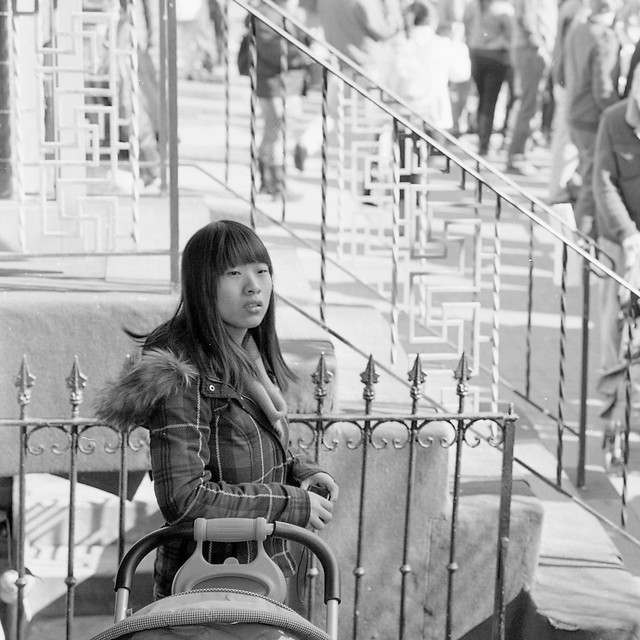Chinese New Year Spectator, by Reed A. George
Leica CL, Voigtlander Heliar 75mm f2.5 Lens
I love to shoot film. I have found that over time, my choice of film has become easier. Rather than worry about color balance, contrast level, etc., I just go for a low contrast film, and adjust everything in Lightroom, after scanning. The reason I go for low contrast film is that you can always add contrast; you can't take it away. Fuji Reala 100 is (was) an incredibly good film for scanning. Now, I generally just buy inexpensive Fuji film of the speed I need. Actually, in retail stores, that's typically reduced to iso 200 and 400 only.
Anyway, I also normally use color film, even when I'm planning to have the final image live in black and white (b&w). Black and white conversion is so easy, good, and flexible in Lightroom that I rarely think about shooting black and white film anymore. When I did shoot b&w film, many times I would choose the films that could be developed in the ubiquitous C-41 process. This allowed me to just drop the film off at the local drugstore and get it back in an hour.
Mike Johnston of The Online Photographer has posted a piece on Ilford XP2 Super, which is a C-41 b&w film, and how to best use it. The C-41 b&w films, in addition to being convenient for quick processing, are also known to be very flexible in exposure latitude. That means that if you don't get the exposure just right, it's okay. Many people use this to push the film's native speed of iso400 to 800, or even higher. However, Mike suggests against that.
(Click Here) to read Mike's article on The Online Photographer.
Mike takes advantage of XP2 Super's characteristics to maximize the effect of the film's low grain in bright areas by typically overexposing, by shooting it at lower iso settings than the nominal 400. Here are his guidelines for iso settings with XP2:
- In normal lighting situations, shoot at iso 200.
- In very bright situations, shoot at iso 100.
- In dim lighting, shoot at iso 400, never over 800.
Go grab yourself a roll and try it out. And remember, to get the best out of XP2 Super, overexpose rather than underexpose it.
DMC-365.blogspot.com

“Life is divided in three parts: at first, you have time and inclination but lack money. Then, you have money and inclination but lack time. Finally, you have money and time but lack inclination.”
ReplyDeleteThanks, Rickster. I have met a few exceptional people who don't fall into this pattern. I remember a guy to took me on a kayak tour around the harbor in Vancouver, BC. He had lost a teenage son in an accident. At that moment, he left his work, had enough money to live (not wealthy), had time, and had the inclination to go paddling around the harbor with me. He gave me that exact information during the trip, saying that while money was a little tight, he was happy to have time and still have inclination.
ReplyDeleteI want to keep the inclination for a very long time, and hope that no personal catastrophe is necessary to put me on the right path.
Reed
DMC-365.blogspot.com